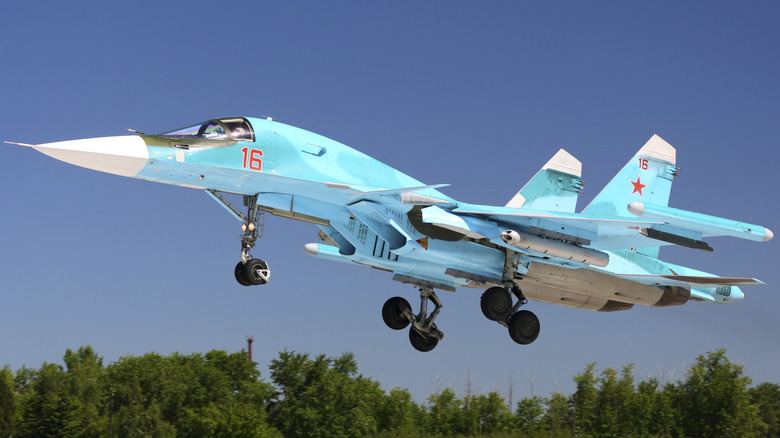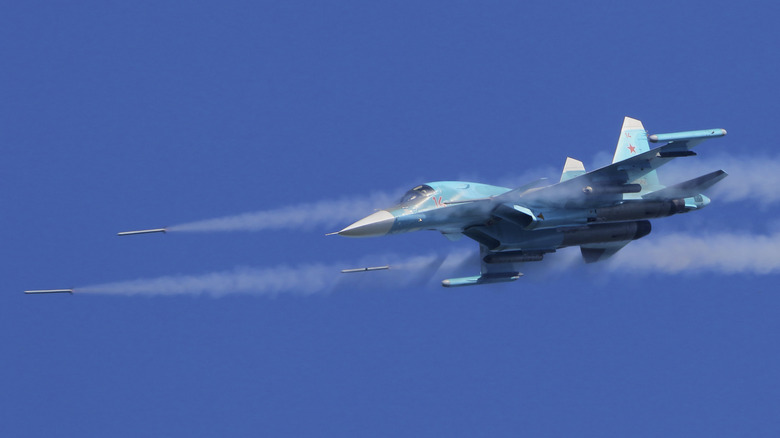How Many Su-34 Bombers Does Russia Have?
Since its introduction in 2014, the Sukhoi Su-34 fighter bomber has been an important part of the Russian Air Force's armory, a point highlighted by its extensive use in the Ukraine conflict. The fighter-bomber (its NATO reporting name is Fullback) is a twin-engined, medium-range, fighter-bomber strike aircraft that is something of an airborne multi-tool. The twin-crewed plane can be used for tactical bombing strikes and air-to-air combat roles. It's capable of carrying a range of munitions, including cruise missiles and a multitude of rocket and bomb systems.
So, how many of these versatile fighter-bombers does Russia have in its arsenal? As ever with Russia, official figures are hard to come by — especially during wartime. However, it is believed that the Russian air force had 163 Su-34s at the beginning of the Ukraine conflict. The Su-34's role in the Ukraine conflict means that working out precise losses is challenging, but according to Oryx, the open-source intelligence (OSINT) platform that only counts visually confirmed losses, there have been 37 Su-34 losses and one loss of the latest Su-34M variant, as of the time of writing.
This means the Russian Air Force would have about 123 Su-34s at its disposal, but that isn't quite the end of the story. Production of the aircraft is still ongoing, and again, while estimates vary, there are believed to have been about 20 Su-34s delivered between 2022 and the first half of 2024, bringing the total to 143. Additionally, according to the official Telegram channel for Russia's United Aircraft Corporation (UAC), the production rate of the aircraft has doubled.
Su-34 -- Technical and operational background
While it first flew in 1990, the 4th-generation fighter/bomber had to wait nearly a quarter of a century before officially entering service on March 18, 2014. The project's delay was down to the economic crisis that occurred after the dissolution of the Soviet Union. Along with its role as a strike aircraft, modified versions have been used in electronic jamming and reconnaissance roles. This Su-34 is not a small aircraft, with a maximum take-off weight (MTOW) of 87,082 pounds. For comparison, an F-35 has an MTOW of 70,000 pounds, and the Gnat — one of the smallest jet fighters of all time — weighed in at 8,630 pounds. Despite this weight, the Su-34 is no slouch, and according to the manufacturer, the plane has a top speed of 932 mph (1500 kph). However, the U.S. Army's Operational Environment Data Integration Network (ODIN) lists its maximum speed as 1,181 mph (1,900 kph). Powering the aircraft are two Saturn AL-35F turbofans that produce 30,866 pounds of thrust.
Infamously, Russia has been using the Su-34's long-range targeting systems to launch air-dropped KAB glide bombs and other munitions from distances of up to 160 miles. It hasn't come without cost, though. The accounted-for losses of 38 aircraft represents about a quarter of Russia's fleet at the start of the war. While it would be wrong to speculate on the reasons for such losses, a lack of 5th-generation aircraft features like stealth and radar-absorbent materials certainly leaves 4th-gen aircraft like the Su-34 more vulnerable to modern air defenses.

